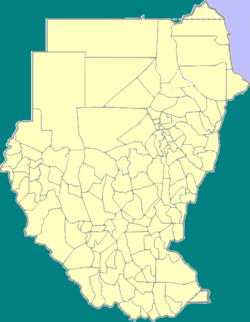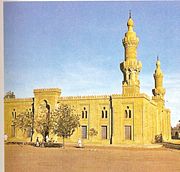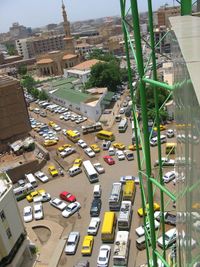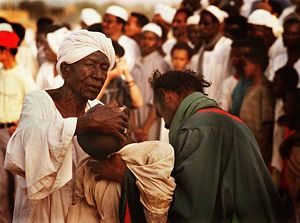Khartoum
2008/9 Schools Wikipedia Selection. Related subjects: Africa; Cities
| Al-Khartoum, Sudan الخرطوم |
|||
| Khartoum at the Bend of the Nile | |||
|
|||
| Nickname(s): The Triangular City | |||
| Khartoum's location in Sudan | |||
| Coordinates: | |||
|---|---|---|---|
| Government | |||
| - Governor | Abdul Halim al Mutafi | ||
| Population (2005) | |||
| - Urban | 2,207,794 | ||
| - Metro | 8,000,000 Agglomeration | ||
Khartoum (الخرطوم al-Kharṭūm) is the capital of Sudan and of Khartoum State. It is located at the confluence point of the White Nile coming in from the north from Lake Victoria, and the Blue Nile flowing west from Ethiopia. The location where the two Niles meet is known as "al-Mogran". The main Nile continues to flow north towards Egypt and the Mediterranean Sea.
Divided by the Niles, Khartoum is a tripartite metropolis with an estimated overall population of over a million people consisting of Khartoum proper, and linked by bridges Khartoum North called (al-Khartūm Bahrī) and Omdurman (Umm Durmān) to the west.
Etymology
From an article by C.E.J. Walkly: "The word 'Khartoum' means 'elephant’s trunk' in the dialect which was spoken locally, the name of the town is probably derived from the narrow strip of land extending between the blue and White Niles, which is like the trunk of an elephant. Captain J. A. Grant, who reached Khartoum in 1863 with Captain Speke’s expedition, thought that the derivation was most probably from the safflower (Carthamus Tinctorius L.) which is called 'Gartoon,' and which was cultivated extensively in Egypt for its oil, used in burning. This explanation is ingenious but has no support."
History
Early history
Ibrahim Pasha, the adopted son of Muhammad Ali, the ruler of Egypt, founded Khartoum in 1821 as an outpost for the Egyptian army, but the settlement grew as a regional centre of trade, including the slave trade. Troops loyal to the Mahdi Muhammad Ahmad began a siege of Khartoum on March 13, 1884 against the defenders led by British General Charles George Gordon. The siege resulted in the massacre of the Anglo-Egyptian garrison.
The heavily damaged city fell to the Mahdists on January 26, 1885. Omdurman was the scene of the bloody battle on September 2, 1898, during which British forces under Horatio Kitchener defeated the Mahdist forces defending the city.
In 1899, Khartoum became the capital of Anglo-Egyptian Sudan and, with the independence of Sudan in 1956, the capital of the new country.
Recent history
In 1973, the city was the site of a hostage crisis in which members of Black September held ten hostages at the Saudi embassy, five of whom were diplomats. The US ambassador, the US deputy ambassador, and the Belgian Chargé d'affaires were murdered. The remaining hostages were released (see 1973 Khartoum diplomatic assassinations). A 1973 United States Department of State document, declassified in 2006, concluded "The Khartoum operation was planned and carried out with the full knowledge and personal approval of Yasser Arafat."
The first oil pipeline between Khartoum and Port Sudan was completed in 1977.
Throughout the 1970s and 1980s, Khartoum was the destination for hundreds of thousands of refugees fleeing conflicts in neighboring nations such as Chad, Eritrea, Ethiopia and Uganda. The refugees settled in large slums at the outskirts of the city. From the mid-1980s onward, large numbers of internally displaced from the violence of the Second Sudanese Civil War and Darfur conflict have settled around Khartoum.
Following the 1998 U.S. embassy bombings, the United States accused Osama bin Laden's al-Qaeda group of responsibility and launched cruise missile attacks ( August 20) on the al-Shifa pharmaceutical factory in Khartoum North. The destruction of the factory produced diplomatic tension between the U.S. and Sudan.
After the sudden death of SPLA head and vice-president of Sudan John Garang at the end of July 2005, there were violent riots in the capital for some days. The death toll was at least 24 as youth from South Sudan attacked North Sudanese and clashed with security forces.
The Arab League summit of March 28-29, 2006 was held in Khartoum, during which the Arab League awarded Sudan the Arab League presidency.
On 10 May 2008 the Darfur rebel group of the Justice and Equality Movement moved into the city where they engaged in heavy fighting with Sudanese government forces. Their goal was the toppling of Omar Hassan al-Bashir's government, though the Sudanese government succeeded in beating back the assault.
Demographics
| Year | Population | |
|---|---|---|
| City | Agglomeration | |
| 1907 | 69,349 | k. A. |
| 1956 | 93,100 | 245,800 |
| 1973 | 333,906 | 748,300 |
| 1983 | 476,218 | 1,340,646 |
| 1993 | 947,483 | 2,919,773 |
| 2007 Estimate | 2,207,794 | 8,363,915 |
Economy
After the signing of the historic Comprehensive Peace Agreement between the government of Sudan and the Sudan People's Liberation Movement (SPLA), the Government of Sudan has begun a massive development project. The biggest projects taking place right now in Khartoum are the Al-Mogran Development Project, two five-star hotels, a new airport, Mac Nimir Bridge (finished in October 2007) and the Tuti Bridge that links Khartoum to Tuti Island.
Khartoum is very poor, with few exclusive areas. Few streets are paved, but the centre is well-planned, with tree-lined streets. However, Khartoum has the highest concentration of economic activity in the country. This is slowly changing as major economic developments take place in other parts of the country, like oil exploration in the South, the Giad Industrial Complex and White Nile Sugar Project in Central Sudan, and the Merowe Dam in the North.
Among the city's industries are printing, glass manufacturing, food processing, and textiles. Petroleum products are now produced in the far north of Khartoum state, providing fuel and jobs for the city. One of Sudan's largest refineries is located in northern Khartoum. Moreover, a number of East-Asian companies have recently shown interest in the realization of a new project which will lead to the creation of new telecommunication services throughout the country.
Education
Khartoum is the main location for most of Sudan's top educational bodies, including but not limited to:
High Schools
- Unity High School. The school came to international attention on November 25, 2007 when one of its teachers, Gillian Gibbons from Liverpool, England, was arrested by Sudanese authorities for allegedly insulting Islam by allowing the children in her class to name a teddy bear "Muhammad".
- Comboni, Khartoum American School and St. Francis
Universities
- University of Khartoum. Founded as Gordon Memorial College in 1902, it was later renamed to share the name of the city in the 1930s.
- Juba University, relocated from Juba during the civil war. Currently, the only university in Sudan which maintained English as language of instruction. Plans exist to relocate the university or part of it back to Southern Sudan.
- Computerman College, the college for computer studies. And recently added other departments.
- Al Neelain University
- Sudan University of Science and Technology. One of the main Engineering and technical schools in Sudan founded in 1932 as Khartoum Technical Institute and then later on 1991 turned into Sudan University of Science and Technology.
- Bayan Science and Technology University
- The Academy of Medical Sciences and Technology. Better known as AMST, it was founded in 1996 by Prof. Mamoun Humaida and built in Khartoum.
- Omdurman Islamic University
- Ahfad University for Women
- Academy of Medical Sciences and Technology, Khartoum
- Comboni College for Science and Technology, Khartoum
Transportation
Air
Khartoum is home to the largest airport in Sudan, Khartoum International Airport. It is the main hub for Sudan Airways, Sudan's main carrier. It was built in the southern edge of the city, but the rapid growth of the city and through the major urbanization, it has become the heart of the city. A new international airport is currently being built in the city of Omdurman. It will replace the current airport in Khartoum as Sudan's main airport followed by Juba Airport and Port Sudan Airport.
Bridges
The following bridges cross the Blue Nile and connect Khartoum to Khartoum North:
- Mac Nimir Bridge
- Blue Nile Road & Railway Bridge
- Kober Bridge
- Shambat Bridge
- Elmunsheya Bridge
The following bridges cross the White Nile and connect Khartoum to Omdurman:
- White Nile Bridge
- Fitayhab Bridge
- Al Dabbaseen Bridge (Under Construction)
- Omhuraz Bridge (Proposed)
- Omdurman-Tuti Suspension bridge proposed - designed by Ahmed Mohammed , Abdalrahmman alrashid , Firas Mohammed , Yassir Abdalla for more info 00249923202320
Rail
Khartoum has rail lines from Egypt, Port Sudan and El Obeid. Some renewings may take place at the trains machinery and cabinets by an Italian company.
Culture
Museums
The largest museum in Khartoum, and indeed all of Sudan, is the National Museum of Sudan. Founded in 1971, it contains works from different epochs of Sudanese history. Among the exhibits are two Egyptian temples of Buhen and Semna which were originally built by Queen Hatshepsut and Pharaoh Tuthmosis III respectively but relocated to Khartoum upon the flooding of Lake Nasser.
Another museum in Khartoum is the Palace Museum, located adjacent to the historical Presidential Palace on Blue Nile Street.
Shopping
Khartoum doesn't have as many open markets or souqs as neighboring Omdurman, but one of the largest is the Souq Arabi. The market is huge and spread over several blocks in the centre of Khartoum proper just south of the Great Mosque (Mesjid al-Kabir) and the minibus station. It is divided into separate sections, including one focused entirely on gold.
Al Qasr St. and Al Jamhoriyah St. are considered the most famous high streets in Khartoum State.
Located in the southern suburb Arkeweet, recently the first medium scale shopping mall opened. Afra Mall mall with a supermarket, retail outlets, coffee shops, a bowling alley, and a movie theatre.
Botanical Gardens
Khartoum is home to a small botanical garden, in the Mogran district of the city.
Clubs
Khartoum is home to several clubs such as the Sailing Club, German Club, Greek Club, Coptic Club, Syrian Club, International Club etc.
Trivia
There is also a Pinewood film on the battle of the mahdi arms against General Gordon called Khartoum. In the book and the film, "The Godfather", the champion horse whose head is severed is named Khartoum.
Twin cities
 Amman Jordan
Amman Jordan Cairo Egypt
Cairo Egypt Istanbul Turkey
Istanbul Turkey Ankara Turkey
Ankara Turkey Saint Petersburg Russia
Saint Petersburg Russia Wuhan People's Republic of China
Wuhan People's Republic of China Asmara Eritrea
Asmara Eritrea






